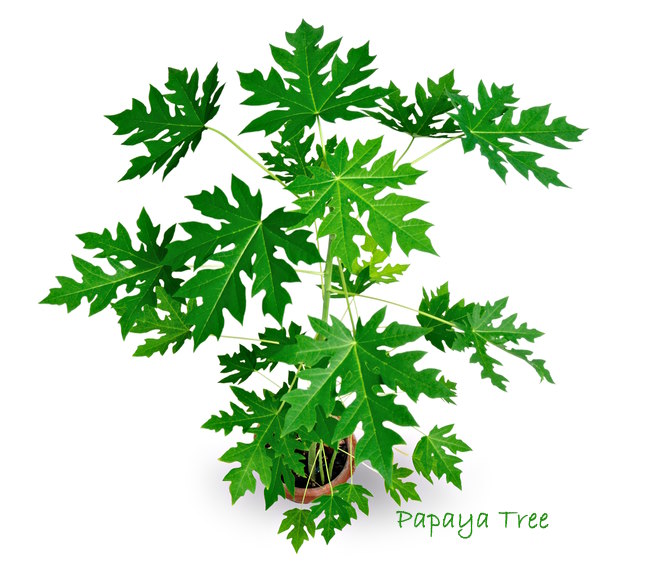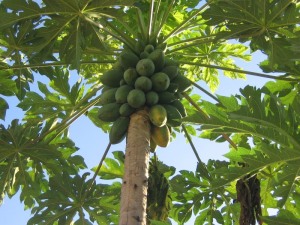How to Grow Papaya Tree Indoors
Botanical Name: Carica papaya
Growing papaya tree as a house plant will give you a dramatic tropical accent for a sunny room. And, that's not all. You'll soon be enjoying the fruits of your labor.
 Photo credit © Montrey Lamy
Photo credit © Montrey LamyGet to Know Your Papaya Plant
Papaya is a fast-growing fruit tree with an unbranched woody trunk. Its big leaves are spectacular. Deeply lobed into 5-9 segments, they're held on long, horizontal petioles at the top, giving papaya tree the look of an umbrella. Papayas do not need to be pruned.
Put this tropical native in a warm, sunny spot year-round. If you move it outdoors for the summer, protect it from strong winds. Also, bring it in when the temperature drops below 60°F/16°C. Papayas don't like the cold at all. Two things will quickly kill papaya trees -- frost and soggy soil.
Trumpet-shaped papaya flowers appear in the leaf axils of the tree in the summer. The fragrant, creamy white or yellow flowers are tiny -- just 1 inch (2.5 cm) long, with 5 petals.
Papaya flowers may be male or female. Carica papaya 'Solo' carries both types of flowers. Some papaya trees that are grown indoors may need to be hand-pollinated to trigger fruit production. It's a good idea to find out from the nursery whether hand pollination is needed for your tree to produce fruit.
How to pollinate a papaya: Use a small, dry paintbrush to dab each flower. Wiggle the brush around the center of each flower, moving from flower to flower. This carries pollen from male to female flowers, just like bees do it.
The fruits change from deep green to yellow as they ripen. Harvest papaya fruits when they are mostly yellow. Allow fruit to ripen a few more days at room temperature. It's ready for eating when the skin is fully yellow and slightly soft to the touch. Green papayas should not be eaten raw, and will not properly ripen if picked while still green.
Papaya fruit has juicy, firm flesh, and is slightly sweet. It's also good for you. One of the health benefits of papaya fruit is that it contains the enzyme papain, which aids in digestion.
Repot young plants every year. Move to a pot only 1 size larger when the roots fill the container. Use a heavy pot to prevent toppling, and make sure it has a drainage hole to prevent root rot.
Watch for pests and diseases. Papaya trees aren't bothered much by insects indoors. However, watch for spider mites, which love dry conditions in winter. Thrips and white flies may also be invaders. Treat any infestation immediately. An all-purpose organic spray of neem oil will get rid of pests and mildew. Do not spray fruits that will be eaten.
Papaya trees aren't long-lived and will likely need replaced every 4 years or so.
Buying Tips
Buy papaya plants from a reputable grower. Want a dwarf citrus tree? C.p. 'T.r. Hovey' is a dwarf cultivar that only reaches 4-8 ft (1.2-2.4 m), making it an ideal indoor tree. You'll find indoor fruit trees for sale from online nurseries.
You can also grow papayas from seed. You'll find papaya seeds for sale from nurseries. Or you can save them from the fruit for planting, but they may not grow true to type.

Papaya Tree Care Tips
Origin: Southern Mexico and Central America
Height: Up to 10 ft (3 m) when grown in a container. Dwarf varieties are only 4-8 ft (1.2-2.4 m).
Light: Full sun. Give your papaya tree as much direct sunlight as you can year-round. Moving it outdoors for the summer will help the fruits to ripen. Turn the plant a quarter turn every week because it will tend to grow toward the light source.
Water: Keep the soil moist in hot weather and drier in the winter. Water thoroughly, but don't allow the soil to get soggy which can quickly kill this fruit tree.
Humidity: Try to maintain 40-50% relative humidity. The most efficient way to raise humidity around tropical houseplants is with a cool-mist room humidifier.
Temperature: Average room temperatures (65-75°F/18-24°C) suit this tropical tree just fine. Aim to keep it warm year-round. If you put your plant out on the patio for the summer, don't worry -- it can take the heat. Just bring it back in when the temperature drops. Prolonged cold can damage the tree, and even a brief exposure to 32°F/0°C can kill a papaya tree.
Soil: Slightly acidic (pH balance of 6.0-6.5) potting mix that drains well.
Fertilizer: Feed monthly in spring and summer. I highly recommend organic fruit tree fertilizer. It contains all the nutrients citrus trees need for healthy root growth and promotes flowers and fruits.
Propagation: You can grow papayas from seed. Sow seeds in moist perlite and cover pot with a plastic bag to maintain humidity. Keep in a warm, bright place. For best results, use a heat mat to maintain a steady 75°/24°C temperature. Seeds should germinate in about 5-8 weeks. You can expect flowers in 10-12 months.


